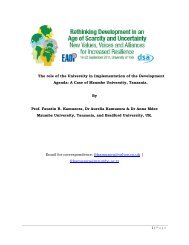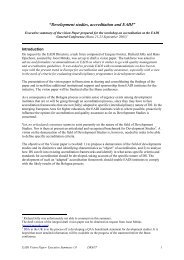Revenue Administration in Sub-Saharan Africa - International Tax ...
Revenue Administration in Sub-Saharan Africa - International Tax ...
Revenue Administration in Sub-Saharan Africa - International Tax ...
You also want an ePaper? Increase the reach of your titles
YUMPU automatically turns print PDFs into web optimized ePapers that Google loves.
B. <strong>Revenue</strong> adm<strong>in</strong>istration expendituresIntroductionCost of collection ratios provide a crude but crucial measure of how efficiently andeffectively resources are used to adm<strong>in</strong>ister revenue collection. <strong>Revenue</strong> bodies wereasked to provide <strong>in</strong>formation on aggregate cost of collection and details ofexpenditures on salary and IT related costs. Detailed <strong>in</strong>formation was not available andmost revenue bodies faced difficulties provid<strong>in</strong>g disaggregated expenditure data. Thedata and analysis presented <strong>in</strong> this section is therefore for <strong>in</strong>dicative purposes only.Survey results (Tables 12, 13 and 14)• Cost of collection ratios varies widely; from a low of about 1% (which is <strong>in</strong> l<strong>in</strong>ewith OECD countries’ limit of 1%) to a high of close to 4%).71• The majority of revenue bodies have cost of collection ratios averag<strong>in</strong>g 2-3%.• Dur<strong>in</strong>g the period 2006 to 2008, cost of collection ratios either rema<strong>in</strong>edstagnant or decl<strong>in</strong>ed for the majority of the revenue bodies.• Salary and related expenditures account for the largest portion of the budget,rang<strong>in</strong>g between 60 to 80% of the expenditure.• <strong>Revenue</strong> bodies’ expenditures on IT <strong>in</strong> 2008 ranged from about 0.8% to 8% ofaggregate adm<strong>in</strong>istrative expenditures.Key observationsCost of collection is <strong>in</strong>fluenced by a number of factors, rang<strong>in</strong>g from optimality of taxpolicy and system, distribution and structure of the taxpayers, effectiveness of revenueadm<strong>in</strong>istration systems and procedures, tax adm<strong>in</strong>istration arrangements between thecentral and local government, to economic and environmental factors exist<strong>in</strong>g <strong>in</strong> acountry. The scope and breadth of responsibilities placed on revenue bodies (such ascollection of a wide range of non-tax revenues) also varies widely and this too<strong>in</strong>fluences the cost of collection. These factors may expla<strong>in</strong> the wide variation <strong>in</strong> coststructure of revenue bodies. 72 It was not possible, with the available data, to fullyassess the cost structures of revenue bodies and draw mean<strong>in</strong>gful lessons/conclusions.In addition some revenue bodies are funded separately by their respective m<strong>in</strong>istries off<strong>in</strong>ance for <strong>in</strong>frastructure development projects (such as huge IT <strong>in</strong>vestments orpurchase of build<strong>in</strong>gs). Fund<strong>in</strong>g by development partners also accounts for asignificant portion of resourc<strong>in</strong>g for a number of revenue bodies. This notwithstand<strong>in</strong>gcost of collection ratios seem to be, relatively, on the high side. Salary and relatedexpenditures account for the largest portion of the budget (up to 80%), which seems tobe consistent with estimates for most revenue bodies <strong>in</strong> the OECD. However, as alreadymentioned, ma<strong>in</strong>ta<strong>in</strong><strong>in</strong>g an appropriate balance <strong>in</strong> staff allocation, for examplebetween headquarters and field operations, can be challeng<strong>in</strong>g and 30% of staff <strong>in</strong>most of the surveyed revenue bodies are based at the headquarters and supportfunctions departments. Another area worth not<strong>in</strong>g is the disparity <strong>in</strong> resourc<strong>in</strong>g the IT71 Survey data was found to be <strong>in</strong>consistent and unreliable. In addition, it is not clear that the figure captured totalexpenditure, <strong>in</strong>clud<strong>in</strong>g donor funded projects.72 Low ratios <strong>in</strong> Botswana and South <strong>Africa</strong> may also be attributed to the <strong>in</strong>clusion of resource taxes <strong>in</strong> the total revenuecollection figure, while the credibility of the low ratio <strong>in</strong> Ben<strong>in</strong> could not be expla<strong>in</strong>ed and may be doubtful.50





